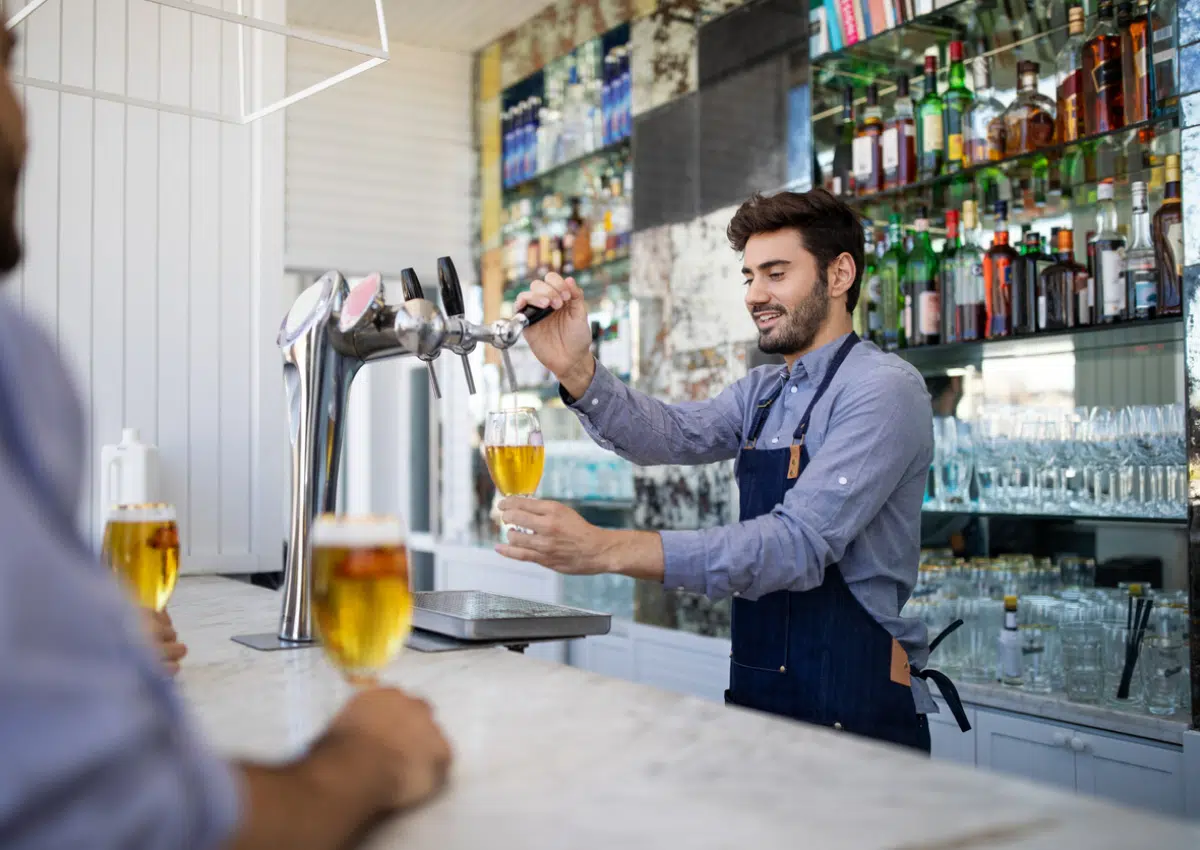Restaurants that sell alcoholic beverages typically experience a boost in their total sales. Food sales generally account for 60-70% of gross revenue, while alcohol sales often account for 80% or more of gross profit dollars.
Alcoholic beverages can generate this revenue boost because of the notoriously high markups. The average markup on beer is around 300%, but that can depend on the type of beer.
Since alcohol consumption shows no signs of slowing down, bars and restaurants can keep their alcohol profits high with the help of a POS system to track inventory, improve ordering accuracy, and make bartenders’ jobs easier.
In this blog, we’ll explore the top benefits and best features of a POS system for bars, providing you with valuable insights to make an informed decision when looking for your POS system.
3 Benefits of Bar POS Systems
1. Inventory Tracking
It’s critical for bar managers to keep track of all liquor inventories to keep the alcohol’s profit margin high. One problem plaguing many bars is inaccuracy of bartenders’ pours and mistakes with ringing in drink orders.
For instance, if a bartender over pours your well vodka by 30 percent (1.62 fl oz instead of 1.25 fl oz), and a restaurant sells their drinks for $4.00 each, they would lose about $25 of profit per bottle.
And if your restaurant goes through 100 bottles of vodka per month that means you could lose $2,500 per month on over-pouring alone.
When managers are able to keep a close eye on actual inventory levels and compare those to the POS system’s tracked inventory levels, they can eliminate the potential revenue loss on account of their staff’s over-pouring or ordering mistakes.
2. More Accurate Ordering
Since a POS system is able to track sales along with inventory, managers can use long-term data to determine busy times of year and busy days of the week to help accurately order alcohol.
It’s a problem if restaurants constantly run out of ingredients for popular drinks and disappoint their loyal customers. Ultimately, under stocking can result in a loss of customers, which will have a negative effect on revenue.
Though frequent customers may only account for 15% of your customer base, they usually contribute to at least 1/3 of restaurant revenue.
3. Improve Bartender’s Experience
In a busy environment, the last thing a bartender wants to do is worry about having to manually input orders and deal with a primarily cash system.
A bar POS system can make their job easier and more efficient with buttons for each drink on the menu, and will improve the accuracy of inputting orders during high-volume hours.
Bars can lose up to 20-30% of inventory because of spills and unrecorded drinks. An easy-to-use POS system will limit loses due to accidental “on the house” drinks during peak bar times.
If bartenders’ consistently input orders correctly, inventory reports will be more accurate for ordering the right amounts of alcohol, and further reduce the potential for revenue loss.
5 Best POS Features
1. Check Splitting
One of the most asked questions when a large group of people are out drinking together, can we split the check? Due to the high markups of alcohol, tabs add up very quickly, and most of the time, no one wants to pay for the lengthy and expensive bill. This is where check splitting comes in and saves the night!
Check splitting easily allows your bartenders to split up checks and move around items between tabs with just a tap and a drop on the payment screen. Your bartenders can say goodbye to the hassle and confusion of bill-splitting with this efficient and user-friendly feature.
2. Customization
With the power of customization on your bar POS system, your server can easily track and fulfill specific requests from guests.
For example, if a customer wants a tequila espresso martini instead of the classic vodka version, their request can be easily entered into the system for the bartender to reference and ensure accuracy. No more relying on verbal communication or the risk of forgotten orders.
By utilizing customization capabilities, your bar can provide an efficient and personalized experience to enhance the overall customer experience.
3. Menu Management
In the fast-paced world of bar service, effective menu management is crucial. Bars often have daily and happy hour specials, which means the pricing is constantly changing. A bar POS system that can automatically update pricing hassle-free will make a significant difference in streamlining your operations.
By doing so, your bartenders are able to prioritize other responsibilities, saving time and enhancing productivity.
4. Suggested Tips
Looking for a way to boost your tips with minimal effort? Finding a bar POS system that suggests tips after each transaction on a customer-facing display is the answer. Your guests will be prompted to add a tip and sign for their check, making the process both subtle and convenient.
Studies have shown that a tipping screen was effective in “elevating tipping amounts” from customers who would not even think to leave a tip. This process is not only efficient, but it also offers a convenient experience for customers; there’s no need to pull out a calculator or dig for change in your wallet or purse.
5. Mobile POS Software
Give your guests a top-tier wining and dining experience when your staff utilizes mobile POS software. This technology allows servers to access the full menu while also effortlessly placing orders and processing payments all from the palm of their hands.
The benefits of mobile POS software extend to both bartenders and customers. By allowing staff to send drink orders quickly and efficiently, they can attend to customers faster.
Set your bar high with CAKE
CAKE’s all-in-one bar POS system helps businesses streamline the restaurant experience. With top-tier features such as check splitting, customization, menu management, and more – it is easy to see why businesses across the country choose us as their preferred system.
Our innovative technology is an emerging favorite on Capterra’s shortlist of Best Bar POS Software. So, if you’re looking to take your bar to the next level, consider CAKE’s bar POS system. With our top-tier features and emerging industry recognition, we’re confident that we can help you elevate your business to new heights. Contact us today to learn more and get started!







